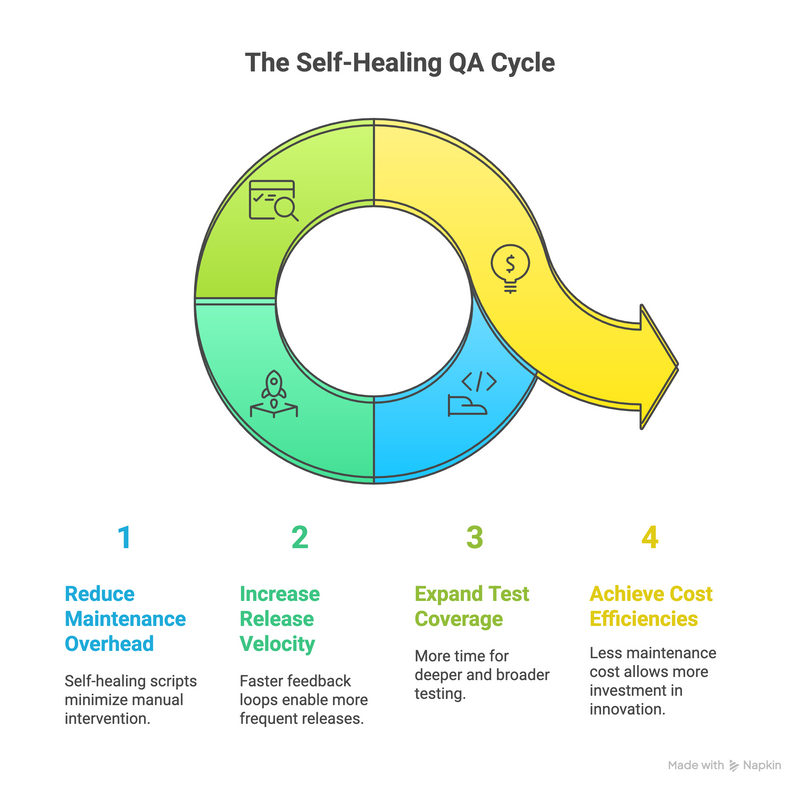Picture this: you deploy a tiny UI tweak—renamed a button or shifted a div—and suddenly your entire test suite blows up. It’s a cycle every QA team knows too well: update, debug, rinse, repeat. But AI’s stepping in to break that loop.
What Is Self‑Healing Test Automation?
Think of it like your tests having adaptive reflexes. Instead of failing when locators break, AI-driven frameworks go, “Cool, here’s the new button,” tweak the script mid-run, and carry on—no human hassle required. This means fewer false negatives and way more stable CI/CD pipelines.
According to GenQE, AI-driven self-healing "automatically detect[s] and update[s] test scripts when application changes occur," cutting maintenance angst drastically.
Additionally, TestingTools.ai notes that nearly 80% of test automation frameworks now include self‑healing features, slashing manual upkeep by up to 60%.
Why It Matters—Especially Now
Maintenance Overload
Traditional brittle scripts demand constant attention. Self-healing? That overhead evaporates.
Release Velocity
With fewer blown-up builds, devs get feedback faster, shipping more often.
Test Coverage Gains
Less time fixing means more time testing deeper, broader flows.
Cost Efficiencies
Time is money. Invest less in maintenance, push more in innovation.
Real-world Tools in the Game
From Testim and Katalon Studio to ACCELQ, low-code AI tools are wrapping self-healing in easy interfaces. The result? Non-technical testers can trigger sturdy tests without knowing a single line of code. It’s an equalizer—and it’s here.
Enter Aurick: The Autonomous AI QA Engineer
Aurick isn’t just another tool — it’s your fully autonomous QA teammate.
It explores your app, creates test cases on its own, runs them, self-heals when things break, finds bugs, and reports everything—all without you writing a single script.
While many tools claim to integrate with CI/CD pipelines, Aurick is built to act like a smart agent, freeing your team from tedious locator fixes and manual testing drudgery. Focus on strategy and product quality, let Aurick handle the grind.
According to AccelQ, modern agile teams demand low-code, self-healing AI tools—and Aurick takes it further with true autonomy that actually works.
Why It’s a Big Deal
| Challenge | Before (Usual QA) | With AI Self‑Healing + Aurick |
|---|---|---|
| Broken locators | Manual fixes, wasted hours | Auto‑repaired mid‑run |
| Maintenance costs | Huge | Minimal |
| Test creation scope | Manual, limited coverage | AI generated wide behavioral chunks |
| Bug visibility | Buried in logs | Clear, prioritized bug reports |
| Pipeline speed | Slows down with failures | Smooth CI/CD flow |
What’s Next?
Self-healing automation isn’t some distant dream—it’s already standard in modern QA. According to Gartner via Testrig, over 80% of test automation frameworks are projected to include AI-based healing by 2025.
But why stop at frameworks? Tools like Aurick are shifting the paradigm: from “helpers” to fully autonomous QA. Once your tests are auto-generated, auto-healing, and bug-reporting, your team moves from firefighting to fine-tuning and innovation.
Final Take
Self-healing test automation is the must-have for any QA or dev team moving fast. If you're still wrestling with script failures over every UI update, you're bleeding resources. AI self-healing tools fix that fast.
And if you want clasp-on reliability with no setup, full coverage, and actionable bug insights—do yourself a favor and check out Aurick. It’s the autonomous QA partner QA dreamt of.




Top comments (0)